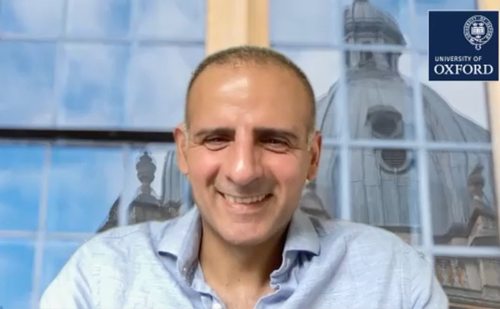The aim of the A DUE study was to assess the combination of macitentan and tadalafil for patients with pulmonary arterial hypertension. In this touchCARDIO interview, we speak with Dr Kelly Chin (UT Southwestern Medical Centre, Dallas, TX, USA) to discuss the findings of the trial and the clinical impact.
The abstract entitled ‘Efficacy And Safety Of Macitentan Tadalafil Fixed Dose Combination In Pulmonary Arterial Hypertension: Results From The Randomized Controlled Phase III A DUE Study’ (Abstract number 409-14) was presented at ACC.23 Together With WCC (ACC.23/WCC) in New Orleans, 4–6 March 2023.
Questions:
- What is the reasoning and benefit of using a macitentan and tadalafil combination for patients with pulmonary arterial hypertension? (0:17)
- What are the aims, design, and eligibility criteria of the phase III A DUE trial? (0:40)
- What were the primary endpoints, and how well were they achieved? (1:33)
- What were the findings in terms of safety and tolerability? (2:46)
- How will these findings be used to inform future treatment decisions for patients with low/intermediate risk pulmonary arterial hypertension? (3:22)
Disclosures: Kelly Chin is a consultant for Acceleron, Gossamer Bio, Janssen, Merck and United Therapeutics, and has received grant/research support from Acceleron, Altavant, Gossamer Bio, Janssen, Merck and United Therapeutics.
Support: Interview and filming supported by Touch Medical Media. Interview conducted by Danielle Crosby.
Filmed as a highlight of ACC 2023
Access more content on hypertension here
Transcript:
Hi, I’m Kelly Chin from UT Southwestern in Dallas, Texas. And I’m the Director of our pulmonary hypertension program here.
Q. What is the reasoning and benefit of using a macitentan and tadalafil combination for patients with pulmonary arterial hypertension?
Well, there are two main reasons for studying it in this study. First, we hoped to learn more about the haemodynamic effects of this combination. Since this endpoint has not been evaluated in this type of study. Second, since both medications are once daily, there is the potential for use as a fixed dose combination as a single pill.
Q. What are the aims, design, and eligibility criteria of the phase III A DUE trial?
The overall objective was to evaluate the safety and efficacy of the macitentan tadalafil fixed dose combination versus each medication as monotherapy. So the study was a 16-week randomized controlled trial with patients randomized slightly differently based on their prior therapy. But the overall randomization ends up with twice as many patients receiving the fixed dose combination versus the monotherapy. Patients underwent testing at baseline and again at 16 weeks. Pulmonary vascular resistance (PVR) assessed using right heart catheterization was the primary endpoint. The eligibility criteria included group one pulmonary arterial hypertension (PAH) and on either no therapy or a phosphodiesterase type 5 (PDE5) inhibitor or an endothelin receptor antagonist (ERA) and function class two or three symptoms.
Q. What were the primary endpoints, and how well were they achieved?
The primary endpoint, more specifically, was the ratio of pulmonary vascular resistance at 16 weeks versus baseline. There were two completely separate comparisons as only the subset of patients on fixed dose combination therapy who were either treatment naive or previously on a PDE5 inhibitor were used in the comparison to the monotherapy PDE5 inhibitor. So there are two endpoints but they are very similar. The fixed dose combination therapy comparator group lowered PVR 44–45%, whereas in the two monotherapy groups, the PVR fell by only 22–23%. Looking at this statistically, this was highly significant and to me is also a clinically relevant decline. The first named secondary endpoint was a 6-minute walk distance. Although there was greater improvement in the fixed dose combination therapy versus monotherapy, this did not reach statistical significance, but it approached it with a p-value just above 0.05 for one of the comparisons. Of note, the study was not powered around this endpoint, but there was a larger numeric increase in the walk distance for the combination therapy.
Q. What were the findings in terms of safety and tolerability?
Overall, the findings were generally as expected. There were two adverse events that we watch for with macitentan, lower extremity edema and anaemia, which we did see in a subset of patients. It is relatively uncommon, but we do watch for this. In most cases, it was not severe enough to discontinue the medication and the overall discontinuation rate, whilst higher in the fixtures combination group at 8%, is still considered low as there are many reasons for discontinuations from studies even beyond adverse events.
Q. How will these findings be used to inform future treatment decisions for patients with low/intermediate risk pulmonary arterial hypertension?
Prior studies have included patients on this combination, but not as the upfront therapy and not with this endpoint. They had very different designs. What I think this study adds is the haemodynamics piece, which I would characterize as both very positive and reassuring as this combination is already frequently used in clinical practice. Since having a larger improvement in PVR is important to us in the treatment of our patients, I think the large decline here reinforces our positive impression of this combination.
Subtitles and transcript are autogenerated














